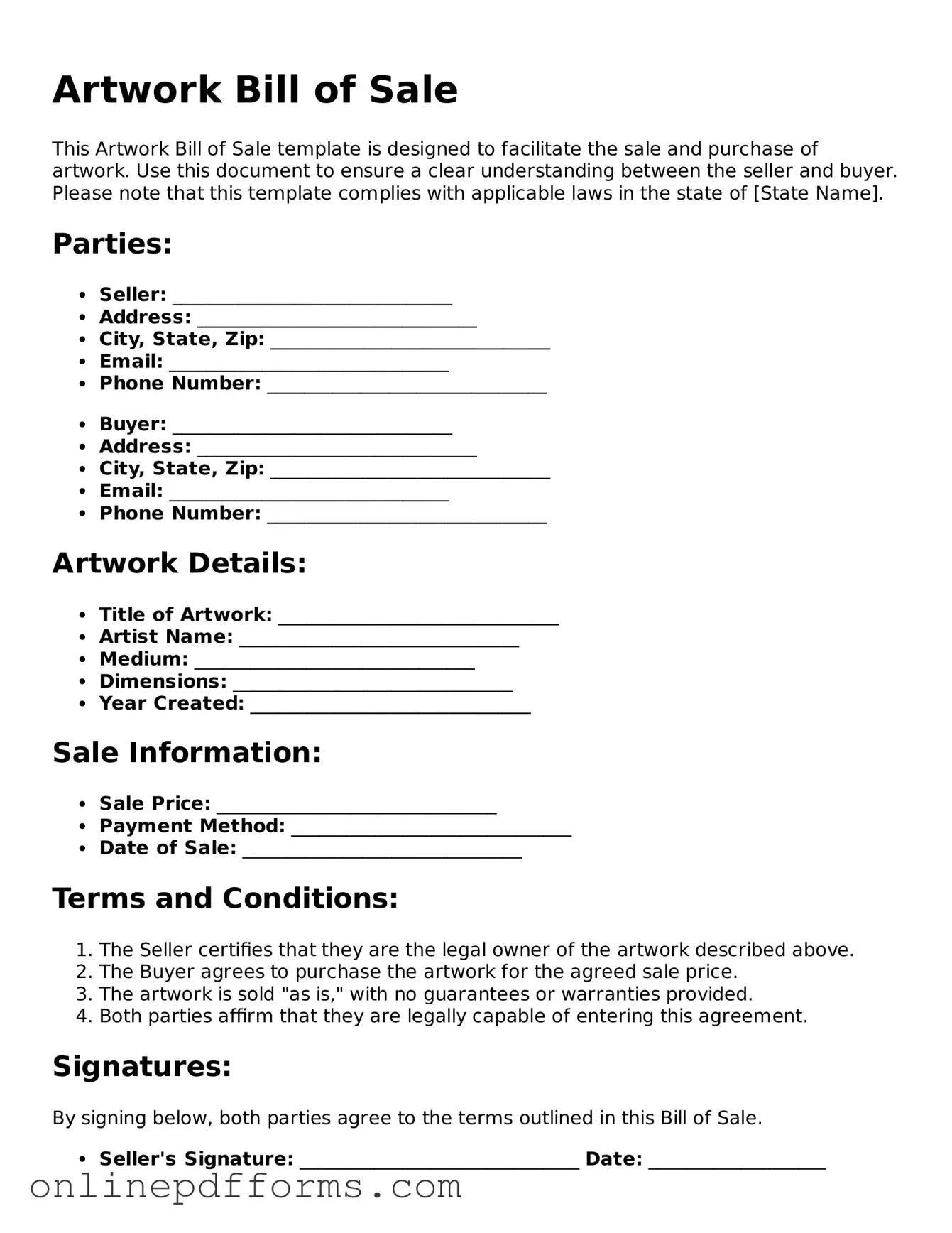The Artwork Bill of Sale form shares similarities with a Real Estate Purchase Agreement. Both documents serve as formal contracts that facilitate the transfer of ownership. In the case of real estate, the agreement outlines the terms under which a buyer acquires property from a seller. Just like an Artwork Bill of Sale, it includes essential details such as the identities of the parties involved, a description of the item or property being sold, and the agreed-upon price. This ensures that both parties are clear about their rights and obligations during the transaction.
Another document that parallels the Artwork Bill of Sale is the Vehicle Title Transfer. When someone sells a vehicle, a title transfer form is required to legally change ownership from the seller to the buyer. Similar to the Artwork Bill of Sale, this document contains vital information such as the vehicle’s identification number, the seller’s and buyer’s details, and the sale price. Both documents aim to provide proof of ownership and establish a clear record of the transaction, protecting the interests of both parties.
The Equipment Bill of Sale is yet another document that resembles the Artwork Bill of Sale. This form is used in transactions involving the sale of equipment, whether for business or personal use. Like the Artwork Bill of Sale, it details the equipment being sold, the identities of the buyer and seller, and the terms of the sale. Both documents serve to confirm the transfer of ownership and can be used as evidence in case of disputes, ensuring that all parties understand the specifics of the transaction.
In the realm of personal property, the Furniture Bill of Sale stands out as another similar document. This form is utilized when buying or selling furniture, providing a clear record of the transaction. It includes details such as the description of the furniture, the sale price, and the names of both parties. Much like the Artwork Bill of Sale, it serves to protect the interests of both the buyer and seller, establishing a formal agreement that can be referenced if any issues arise later.
The Intellectual Property Assignment Agreement also shares characteristics with the Artwork Bill of Sale. This document is used when transferring ownership of intellectual property rights, such as copyrights or trademarks. It outlines the specific rights being transferred, the parties involved, and any compensation agreed upon. Similar to the Artwork Bill of Sale, it ensures that the seller relinquishes all rights to the property, while the buyer receives legal ownership, thus preventing future disputes regarding ownership and usage.
The Business Asset Purchase Agreement is another document that bears resemblance to the Artwork Bill of Sale. This agreement is used when one business acquires assets from another, including tangible items like equipment and intangible assets like intellectual property. Both documents detail the assets being sold, the purchase price, and the identities of the parties involved. They serve to formalize the transaction and provide a clear record of ownership transfer, ensuring that both parties are aware of their rights and responsibilities.
Similarly, the Livestock Bill of Sale is a document used in agricultural transactions. When livestock is sold, this bill provides a record of the sale, detailing the type and number of animals involved, the sale price, and the identities of the buyer and seller. Like the Artwork Bill of Sale, it functions as a legal record that helps prevent disputes and clarifies ownership, ensuring that both parties have a mutual understanding of the transaction.
The Artwork Bill of Sale is akin to a Vehicle Bill of Sale. Both documents serve as proof of transaction, confirming the transfer of ownership from one party to another. Just like a Vehicle Bill of Sale records details such as the seller and buyer's information, as well as the make and model of the vehicle, the Artwork Bill of Sale outlines the particulars of the artwork involved. It includes the names of the parties, a description of the art piece, and the sale price. For those looking to properly document such a transaction, you can access the form that provides a structured approach to creating this essential agreement. This equivalence ensures that both buyers and sellers have a clear record, minimizing disputes in the future.
Lastly, the Boat Bill of Sale is akin to the Artwork Bill of Sale in that it formalizes the sale of a boat or watercraft. This document includes information about the vessel, such as its make, model, and hull identification number, along with the sale price and the parties involved. Both documents serve to establish a clear transfer of ownership and protect the interests of both the buyer and seller, providing a legal framework for the transaction.
